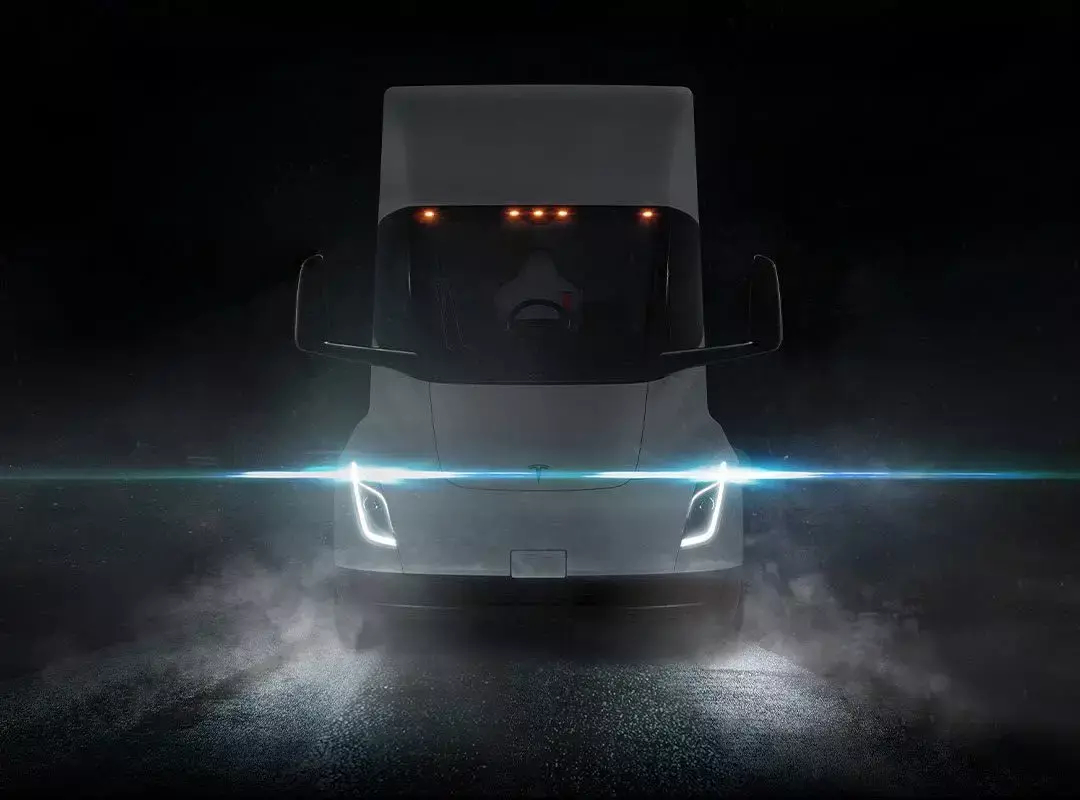A major change to Australian design rules promises to be a “game changer” for Australia’s shift to electric freight transport.
The new rule announced by the federal government will allow wider trucks on Australian roads, bringing the country in line with overseas markets and removing one of the key barriers to local uptake of heavy duty electric trucks, as most overseas-built models were just a few centimetres too wide to meet Australia’s previous standards.
“This Safer Freight Vehicles package responds to direct calls from industry to increase the width limit of trucks and follows extensive public consultation and feedback,” said federal assistant minister for infrastructure and transport Carol Brown.
“These changes will be a real game changer for industry, businesses and other road users, as they will save lives by adopting technology to reduce the likelihood of crashes, while also lowering freight costs and supporting better environmental outcomes.”
The change increases the overall width limit from 2.50 to 2.55 metres for new trucks, as long as they are fitted with safety features such as side guards and devices to limit blind spots.
Bahahaahhaa!
It’s true that Aussie widths are less than some other countries.
But AFAICT these proposed rules are not limited to electric trucks. And don’t think just semis. SUVs, pickups.
Get used to seeing diesel monster trucks rolling coal, and other emotional support vehicles become a lot more common.
RIP cyclists and small children
How about any SUV with huge towing mirrors permanently fitted and extended to their max?
Why aren’t goods transported via train?
The operational overhead is often too time-intensive, among other issues.
You can either send a lad with a truck down the highway or you can send one to a train station somewhere, have him unload everything, wait for the train to leave, the train to get there (you’ll be lucky if it’s going straight where you need it to), have someone go to the destination station, unload it into another truck and finally deliver it.
It’s might only be worth it for veery long trips, and the start and finish have got to be in good locations (harbors f.e.).
It makes sense to use trains, but as soon as you look into it, it becomes almost undoable.
This fact is also reflected in the tonnage statistics.
For non-bulk freight across the Nullarbor, rail has double the market share of Sea transport. Which then has double the market share of Road transport. It’s not the case for Melbourne Sydney though.
Contrary to what the other comments are saying, there’s no compelling reason why goods transport by train can’t be done here when it can be done elsewhere. It was done in the past but then we started spending billions to subsidise trucks and passed a variety of laws to benefit road transport. Plus allowing the taxpayer to cover the cost of road wear caused by trucks which totals more billions per year.
So in the end it was a pure policy decision - in the 1950s various lobby groups pushed for the introduction of laws to favor road transport over rail transport and in 1957 the first laws were passed. The rest is history.
So I’ve been reading up on this topic a bit more and I came across this
Problem Australia’s interstate freight rail network comprises many long sections of single track. This restricts the number of train paths, reducing rail’s competitiveness with road, and hindering rail’s ability to meet growing freight movement demand. The interstate freight rail network needs to be enhanced to accommodate growth in the freight and passenger task, and improve efficiency and safety.
On the bright side it is a proposal to upgrade a lot of the rail corridors to support more freight than we have currently. Though it was added in 2016 and is still only in the ‘potential investment options’ phase
same reason as nuclear power - high startup, low maintainance. Even if the lifetime cost is lower, the initial cost and its associated risk makes these kinds of investments unattractive.
This problem is even worse for trains, because the last miles has to go onto trucks anyways
Seeing as how the majority of truck drivers here in Australia are complete aggro cunts, this should be marvellous as they’ll be able to destroy even more innocent drivers.
This is pretty bullshit mate. I spend so much time on the highway on my bike and truck drivers are usually the most law abiding, predictable drivers I come across.
Yeah there are some who are like you describe but truck drivers are massively overworked and exploited, leading to sleep deprivation and often drug use just to meet targets, so that’s inevitable.
I’d share the road with a semi over a Falcodore or yank tank any day.
Maybe it’s different in other states but in South-East QLD, I’ve had some pretty bad experiences with truck drivers. Just the other week I was in traffic on the Pacific Motorway and an earthmoving truck (tipper with trailer) was effectively tailgating me, barely leaving enough stopping distance for the common sudden stops from 70km/hr. Another truck was flashing his lights and tailgating me at 100km/hr on the Logan Motorway.
But basically everyone on the road is a dickhead so mileage may vary. It’s just scarier when it’s a truck
Tipper drivers are a whole different breed, and the hardcore roadrager driving you see from them is driven by economics cos they mostly get paid by the load not the hours.
Though it’s no excuse for them to make that my problem. If their work conditions are poor they should work somewhere else or unionise
Semi drivers are generally good.
Dump truck drivers have Swiss cheese brains.
To be fair it’s just most Australians are aggro cunts
The fuck you say?
If I had to work on the road full time, I’m sure my patience would also be limited. We’re talking about an increase of 5cm to the width of the trucks. Nobody is going to notice.
I don’t know about that. When I used to ride a bike to work near a busy truck route, I felt like the truck drivers were the most courteous and conscious of keeping a safe distance. Normal car drivers were a mixed bag: usually not a problem, but not reliable enough to trust. But bus drivers… it felt like bus drivers were actively pissed off by the existence of cyclists.
Without Trucks Australia Stops!
Edit: For the benefit of non-australians who are downvoting this, I am being sarcastic in reference to the common “Without Trucks Australia Stops” sign found on the backs of trucks.

How about a rail freight network that works?
Nope. Truck unions bribed hard enough for that not to happen.
This is a very common “fuck cars” solution but it’s not clear exactly what is envisaged.
Rail is currently used only for single commodities. In west aus for example grain is hauled from farms to bins in trucks, then bins to ports by rail. Obviously you can’t send trains to every paddock in every farm.
For mixed freight, a grocer 500km from Perth can order whatever at 5pm and have it arrive by trucj at 12pm, ready for it to be shelved ready for sale the next morning.
High speed freight rail just isn’t viable for WA given the low population density. Even if it were, I wonder at whether mixed freight in such short time frames is possible.
Yes I agree that a mixed method is best. However the current predominant method of road is unsustainable and dangerous. For instance, there is no excuse for an expanded east coast line not doing more to service various hubs which trucks can then the ‘final mile’ (yes I know; many 10’s of Ks) delivery.
deleted by creator
Yeah, I’m not trying to advocate for trucks but in the example I mentioned mixed freight just wouldn’t be competitive.
By truck, the journey of Warehouse > 500km > Shop can be achieved in 7 hours.
By train, warehouse to train would be 2 hours minimum, 500km would be 8 hours minimum, and train to shop would be 3 or four hours minimum. Basically there’s two additional unload & sort & load events in the train journey, and the train is slower. The ~12 hours outlined here is also the absolute best case - most places in West Aus just don’t have the requisite economy of scale.
I guess there must be solutions which just aren’t apparent because this method of freight isn’t common. Shipping containers would be helpful for example.
Unfortunately we don’t have a rail freight network that either works well or reaches every township in Australia, and until we do encouraging the switch from ICE road haulage to EV road haulage is the best way to reduce transport industry emissions.
For a lot of the more rural towns (or a least for the ones I know of) that do have rail connections, they are only accessible using diesel locomotives as there is no electricity network set up to power electric trains. So if we don’t want to introduce more emissions from rail freight we would have to electrify the whole rail network.
Realistically we should be building rail and allowing EV trucks to be more accessible, but Australia is a big place, building all that rail infrastructure will take time. A good stepping stone would be to build rail connections to regional urban centres and then have trucks distributing it to the surrounding towns, but even building that much rail will take time. And that’s just the construction. The amount of time it would take to secure the land corridors for the rail would be considerable alone. AEMO have been having a difficult enough time securing land rights to build transmissions networks across properties
For a lot of the more rural towns (or a least for the ones I know of) that do have rail connections, they are only accessible using diesel locomotives as there is no electricity network set up to power electric trains. So if we don’t want to introduce more emissions from rail freight we would have to electrify the whole rail network.
Hydrogen (and battery) are both viable energy storage methods for heavy rail freight:
Yeah true I didn’t even think about batteries or hydrogen as diesel replacements for trains. The up to 6MWh of storage your article quotes for the short distance hauls sounds like a lot of storage, but I guess there is a considerable amount of surface area at the bottom of a locomotive that could be filled with batteries, and if each locomotive can’t hold enough storage to pull the load, you can just add another locomotive to the train to make up the difference.
the problem though is that the production of batteries produce pollution, and they have a set lifetime, unlike overhead wires.
No doubt, but steel production produces a lot of pollution as well. It will be interesting to see the progression of green steel manufacturing tech and battery tech vs one another over time, even hydrogen tech. Its a tough choice because at any point we could see a major breakthrough in one of them making all the others relatively less cost and environmentally sound options.
So if we don’t want to introduce more emissions from rail freight we would have to electrify the whole rail network.
Sure, but diesel rail transport still produces vastly less pollution than road, not to mention the far cheaper cost per kg
I think it’s far more likely that any lobbying to stymie rail expansion is coming from toll road operators like Transurban.
How about a rail freight network that works?
Nope. Truck unions bribed hard enough for that not to happen.
Hey, would be interested to read up on that. Any online sources handy?
Apologies but no not offhand. I’m pretty sure I’ve seen a couple articles in the past. The Guardian I think.
Shouldn’t be a problem most places, though some roads and docks already feel tight enough at 2.5m.
An extra 5cm inside would be nice though - even that extra little bit of room would often make it easier to get a pair of pallets in.
Ah yes, the electrification of trucks. Where 1/3 of the cargo your hauling is your own batteries. Efficiency at its finest.
The thing is, electric motors are so efficient that even hauling the mass of the batteries they are still more efficient than old fashioned internal combustion engines.
Nah. Diesel engine’s efficiency is ~40%, Electric Motor’s ~75%. Since you’re hauling batteries, you haul less cargo, which means you need more trucks, more trips, more drivers, more charging time, etc.
Truck drivers in Australia are banned from driving more than 5.5 hours at a time. There are already dedicated places to stop and park a large truck every 5 hours or so on every single highway.
A truck that can drive five hours on a charge doesn’t need that big of a battery. Tesla’s semi goes much much further than that on a charge and it would, as you point out, be more efficient if it had a smaller/lighter battery.
I expect where we’ll end up is drivers will, when they stop for their mandatory rest, disconnect the trailer, hook the truck up to charging infrastructure, then connect the trailer to a fresh truck with a fully charged battery.
The charging infrastructure would likely be optimised for price, not speed. For example only charge the truck during the day when the grid is running on solar power.
Diesel trucks are not cheap by the way - maintenance plus the cost of the diesel works out to something like a hundred thousand dollars per year assuming you drive the truck all year.
There are too many questions to be answered to calculate how much money you’d save, since electric trucks don’t exist at all yet, but my city has started deploying electric busses and they work out to a savings of a quarter million dollars per bus (over the life of the bus). Obviously with savings like that, they are going to stop buying diesel busses entirely as soon as they possibly can. It will be the same for trucks.
Well, you’re listing all these things that will happen in the future, seemingly disregarding any other potential advancements in alternative fuels.
Infrastructure, dead batteries, overhauled shipping processes… It’s a lot of change (read: money) for a rather small improvement.
So far, it seems that trucks and batteries simply do not mix. What will happen ‘next year TM’, we’ll see. Right now I am skeptical.
Charging time could be averted by having swappable batteries, perhaps like the swap 'n go gas bottles used for homes. Except, obviously paying a bit on top for the wear of the battery.
It could grip it by the husk!
Suppose two swallows carried it together?
Full self driving next year, surely.
I work for an engineering company… in IT, but I still hear about engineer news as a result. If what’s been said around the office is true, hydrogen makes more sense for electric trucks, even though it doesn’t make sense for cars. Sadly I forget the reasoning. Something about energy density vs the size of the vehicle. I’d be interested to know how it compares to diesel.
And before you bring it up, the problem with generating hydrogen was definitely brought up, particularly how inefficient that part currently is and the fact the energy from it often comes from fossil fuels. I know new, more efficient techniques are being trialed, but beyond that we need to invest more in green energy.










